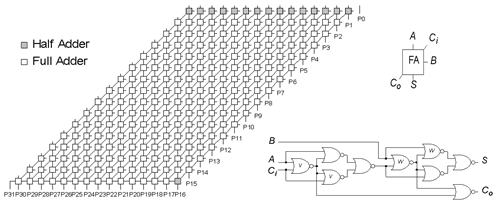
| proposed by | Francisco Azevedo fa@di.fct.unl.pt |
The c6288 digital circuit from the ISCAS’85 set of benchmarks is a 16-bit multiplier, which can be seen as a grid-like pattern of 240 half and full adders (as in Figure below), consisting of 2406 logical gates in all.

High-level model of c6288 Multiplier Circuit and full adder module (images obtained from http://www.eecs.umich.edu/~jhayes/iscas/ ).
C6288 is of special interest in that it has traditionally proven difficult to diagnosis system.
This diagnosis problem uses input vector 01001000000100010001000110100000, corresponding to the multiplication of 34834 by 1416, returning 49324944, represented in binary by (least significant bit first) 00001001110001010000111101000000. From this correct output, a bit at a time is flipped, obtaining 32 incorrect output vectors. For each such incorrect output vector, the goal is to find the set of all single faults that explain it. Additionally, as a harder problem, the goal is extended to find the set of all double faults that explain it.
Circuit description (taken from http://www.eecs.umich.edu/~jhayes/iscas/ ) can be seen here.
The problem is also described in:
José Júlio Alferes, Francisco Azevedo, Pedro Barahona, Carlos V. Damásio and
Terrance Swift, Deductive Diagnosis of Digital Circuits, in First IFIP
Conference on Artificial Intelligence Applications and Innovations (AIAI'2004),
Kluwer Academic Press, pages 155-165, 2004.
where some results are presented.